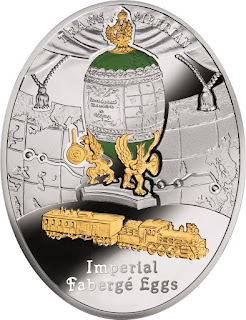Niue Island 1 Dollar Silver Coin 2015 Trans-Siberian Railway Faberge Egg
Series: Imperial Fabergé Eggs
The coin dedicated to the one of the most precious jewellery masterpieces – an exceptional item in each collection!The Mint of Poland presents the “Trans-Siberian Railway Egg” coin released in the series commemorating famous eggs made in a workshop of a world-renowned Russian jeweller, Peter Carl Fabergé. This little pieces of art, which were designed to Russian tsars’ orders, have been a symbol of extravagance and splendor for over 100 years.
Obverse: At the bottom – open „Spring Flowers Egg” (1899-1903) with a miniature basket and a bouquet of anemones. Above the basket – the effigy of Her Majesty Queen Elizabeth II with an inscription: ELIZABETH II and the mint mark (m/w). Around – a decorative, neo-rococo ornament. Along the rim – the issuer’s name: NIUE ISLAND, the face value: 2 DOLLARS, the hallmark (Ag 925) and the year of issue – 2014.
Reverse: In the foreground – an image of the Trans-Siberian Railway Egg with 24-carat gold plated elements of its basis and top. Below – an image of a gold train and an inscription: FABERGÉ EGGS. In the background of the central part of the coin – an outline of a map of Russia. Along the upper rim of the coin – an inscription: TRANS-SIBERIAN. In the background of the upper part of the coin –
a decorative surface stylized to look as a palace curtain.
Design: Beata Kulesza-Damaziak
The Trans-Siberian Railway Egg was an Easter gift from the last Tsar of Russia, Nicholas II, to his wife Tsarina Alexandra Fyodorovna. The inspiration for this coin made in 1900 was a spectacular event of building the Trans-Siberian Railway connecting the European part of Russia with Vladivostok. The interior of the egg reveals a miniature replica of a steam locomotive and five carriages. Not only is the whole train a charming piece of jewellery art, but also a mechanical working model wound up with a gold key. The Trans-Siberian Railway Egg is housed in one of the oldest Moscow museums – the Kremlin Armoury.
• coin of the awe-inspiring “Imperial Fabergé Eggs” collection
• its coin and packaging design characteristic for the 19th century
• sterling silver of .925 purity
• selective gold plating with the use of the most modern machines
• exceptional, ellipse-shaped design
• attractive presentation case embellished with a gold ornament
Country: Niue Island.
Year: 2015.
Face Value: 1 Dollar.
Metal: Silver.
Weight: 16.81g (0.54oz).
Dimensions: 29.2 x 39.0 mm.
Finish: Proof.
Embellished with pad printing.
Very low mintage - limited to only 1,999 pieces.
Series: Imperial Fabergé Eggs
Trans-Siberian Railway Egg 1900 Faberge Gatchina Palace Egg 1901 Faberge
Trans-Siberian Railway - Fabergé egg
The Trans-Siberian Railway Egg is a jewelled Easter egg made under the supervision of the Russian jeweller Peter Carl Fabergé in 1900 for Tsar Nicholas II of Russia. It was presented by Nicolas II as an Easter gift to his wife, the Tsarina Alexandra Fyodorovna. It is currently held in the Kremlin Armoury Museum in Moscow.
Design
The exterior of the 1900 Trans-Siberian Railway egg is made of onyx, silver, gold, and quartz, and is decorated with colored vitreous enamel. The lid of the egg is hinged, has an overlay of green enamel, and is decorated with inlaid leaves of acanthus. On top of the lid is a golden three-headed eagle in gold with the Imperial Crown. The interior is lined with velvet.
A route map of the Trans-Siberian Railway is engraved in silver across the face, with major stations marked by a precious stone, forming a belt around the egg. The egg is supported by three griffins made of gold-plated silver on a stepped triangular base of white onyx.
Surprise
The surprise is a miniature clockwork replica of a steam locomotive made of gold and platinum in three sections, forming a train with a length of one foot. It has a diamond headlight, and ruby marker lights. The train has five carriages with rock crystal windows, labeled “mail”, “ladies only”, “smoking”, “non-smoking” and “chapel”. The train has a gold key that can be used to wind it up and make it run.
History
In 1900, the railway linking European Russia with Vladivostok on Russia’s Pacific coast was nearing completion. This was an accomplishment that, despite its tremendous cost in resources and human lives, brought Nicholas great satisfaction since, as Tsarevitch, he had travelled to the Far East to lay the eastern foundation stone.

